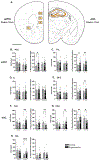Comparison of prefrontal cortex sucrose seeking ensembles engaged in multiple seeking sessions: Context is key
- PMID: 35137974
- PMCID: PMC8940716
- DOI: 10.1002/jnr.25025
Comparison of prefrontal cortex sucrose seeking ensembles engaged in multiple seeking sessions: Context is key
Abstract
Encoding of memories, including those associated with prior drug or reward, is thought to take place within distinct populations of neurons, termed ensembles. Neuronal ensembles for drug- and reward-seeking have been identified in regions of the medial prefrontal cortex, but much of our understanding of these ensembles is based on experiments that take place in a single reward-associated environment and measure ensemble encoding over short durations of time. In contrast, reward seeking behavior is evident across different reward-associated environments and persists over time. Using TetTag mice and Fos immunohistochemistry, we examined the relationship between persistent sucrose-seeking and ensemble encoding in mice that undergo seeking sessions in the same or different sucrose self-administration contexts 2 weeks apart. We found that prelimbic (PrL) and anterior cingulate cortex ensembles tagged in the first seeking session were highly sensitive to the context in which a second seeking session took place: reactivation of these ensembles was reduced in the same context but elevated in a distinct sucrose self-administration context. Correlational analyses revealed that ensemble reactivation in the PrL was proportional to the persistence of sucrose seeking behavior across sessions in differing ways in female mice. In the same context, reactivation was proportional to the persistence of non-reinforced operant responses, whereas in a distinct context, reactivation was proportional to the persistence of non-reinforced head entries into the sucrose receptacle. This study underlines the importance of the medial prefrontal cortex importance in maintaining a reward-seeking ensemble over time and identifies context-dependent changes in behavioral correlates of ensemble reactivation.
Keywords: infralimbic cortex; natural reward; prelimbic cortex; self-administration; sex differences.
© 2022 Wiley Periodicals LLC.
Conflict of interest statement
Conflict of Interest: The authors declare no competing financial interests.
Figures









Similar articles
-
Dissociable dorsal medial prefrontal cortex ensembles are necessary for cocaine seeking and fear conditioning in mice.Transl Psychiatry. 2024 Sep 23;14(1):387. doi: 10.1038/s41398-024-03068-7. Transl Psychiatry. 2024. PMID: 39313502 Free PMC article.
-
From ensembles to meta-ensembles: Specific reward encoding by correlated network activity.Front Behav Neurosci. 2022 Sep 8;16:977474. doi: 10.3389/fnbeh.2022.977474. eCollection 2022. Front Behav Neurosci. 2022. PMID: 36177094 Free PMC article. Review.
-
Distinct Fos-Expressing Neuronal Ensembles in the Ventromedial Prefrontal Cortex Mediate Food Reward and Extinction Memories.J Neurosci. 2016 Jun 22;36(25):6691-703. doi: 10.1523/JNEUROSCI.0140-16.2016. J Neurosci. 2016. PMID: 27335401 Free PMC article.
-
Choice for Drug or Natural Reward Engages Largely Overlapping Neuronal Ensembles in the Infralimbic Prefrontal Cortex.J Neurosci. 2018 Apr 4;38(14):3507-3519. doi: 10.1523/JNEUROSCI.0026-18.2018. Epub 2018 Feb 26. J Neurosci. 2018. PMID: 29483279 Free PMC article.
-
Learning-induced intrinsic and synaptic plasticity in the rodent medial prefrontal cortex.Neurobiol Learn Mem. 2020 Mar;169:107117. doi: 10.1016/j.nlm.2019.107117. Epub 2019 Nov 23. Neurobiol Learn Mem. 2020. PMID: 31765801 Free PMC article. Review.
Cited by
-
Dissociable dorsal medial prefrontal cortex ensembles are necessary for cocaine seeking and fear conditioning in mice.Transl Psychiatry. 2024 Sep 23;14(1):387. doi: 10.1038/s41398-024-03068-7. Transl Psychiatry. 2024. PMID: 39313502 Free PMC article.
-
From ensembles to meta-ensembles: Specific reward encoding by correlated network activity.Front Behav Neurosci. 2022 Sep 8;16:977474. doi: 10.3389/fnbeh.2022.977474. eCollection 2022. Front Behav Neurosci. 2022. PMID: 36177094 Free PMC article. Review.
-
Neuropathic pain has sex-specific effects on oxycodone-seeking and non-drug-seeking ensemble neurons in the dorsomedial prefrontal cortex of mice.Addict Biol. 2024 Aug;29(8):e13430. doi: 10.1111/adb.13430. Addict Biol. 2024. PMID: 39121884 Free PMC article.
References
-
- Brebner LS, Ziminski JJ, Margetts-Smith G, Sieburg MC, Reeve HM, Nowotny T, … Koya E (2020). The Emergence of a Stable Neuronal Ensemble from a Wider Pool of Activated Neurons in the Dorsal Medial Prefrontal Cortex during Appetitive Learning in Mice. J Neurosci, 40(2), 395–410. doi:10.1523/JNEUROSCI.1496-19.2019 - DOI - PMC - PubMed
Publication types
MeSH terms
Substances
Grants and funding
LinkOut - more resources
Full Text Sources
Molecular Biology Databases

